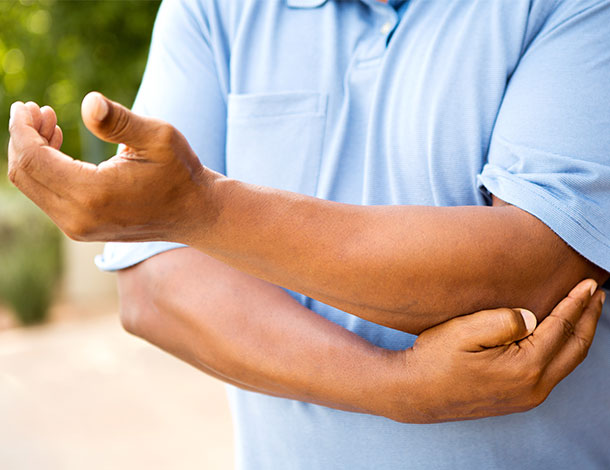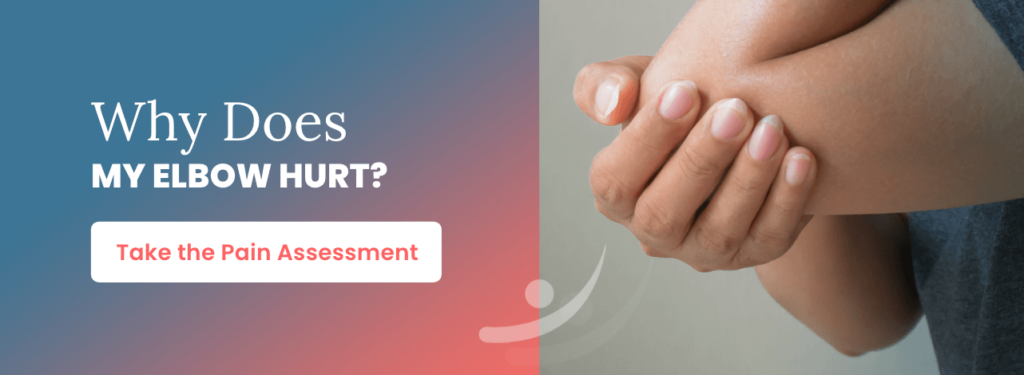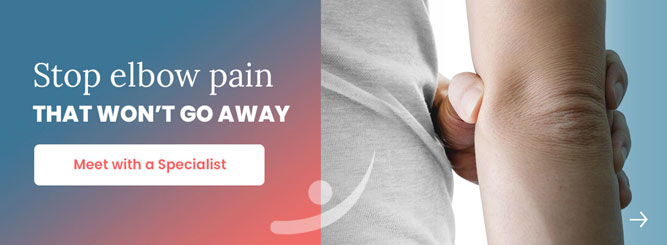What Causes Elbow Arthritis Pain? What Are the Best Treatment Options?

Our elbow joints are essential to doing everyday tasks, so pain and stiffness from elbow arthritis can seriously impact your quality of life.
As you age, your risk of developing arthritis in your elbow joint increases. According to the Centers for Disease Control and Prevention, it’s also a leading cause of disability in the U.S., affecting nearly 59 million people.
This blog article covers the most common types of elbow arthritis and how they’re diagnosed. Read on to learn about non-surgical and surgical options that can relieve the symptoms associated with arthritis of the elbow.
What Causes Elbow Arthritis?
Arthritis of the elbow that occurs without a previous injury is more common in men than women. Symptoms most often begin in people aged 50 years or older.
The two most common types of elbow arthritis are rheumatoid arthritis and osteoarthritis. Post-traumatic arthritis from an injury can also occur.
What Is Rheumatoid Arthritis?
Rheumatoid arthritis is a chronic inflammatory disease that causes inflammation, swelling, and pain in your joints. Rheumatoid arthritis of the elbow is common and often one of the earliest joints affected by the condition.
What Is Osteoarthritis?
Osteoarthritis occurs when the cartilage surface of the elbow is worn out or damaged. This is most commonly the result of normal wear-and-tear on the joint from age and activity.
What Is Post-Traumatic Arthritis?
An injury to the elbow—like a fracture or dislocation—can lead to a progressive deterioration of the joints, known as post-traumatic arthritis.
Can Arthritis of the Elbow Be Prevented?
The best way to prevent arthritis of the elbow is to avoid injury or overuse of the joint. When an injury does occur, getting treatment right away can help prevent further damage.
Maintaining muscular strength around the elbow can help prevent injury, especially in people who are active in sports or jobs that require vigorous use of the elbow joint.
Request an appointment with an elbow specialist
Symptoms of Elbow Arthritis
Symptoms can vary based on the type and severity of elbow arthritis, but the most common ones include:
- Elbow Pain (Especially When Rotating or Bending Your Elbow; Having Pain in Both Elbows Is More Common if You Have Rheumatoid Arthritis)
- Elbow Swelling
- Elbow Joint Instability
- Difficulty Straightening, Bending Your Elbow or Rotating Your Forearm
- Locking or Catching Sensations When Using Your Elbow
How Is Elbow Arthritis Diagnosed?
During a physical exam, your elbow specialist will check for tenderness and swelling and test the range of motion in your elbow. They may also do an X-ray to check for signs of elbow arthritis or other problems in the joint.

How to Treat Elbow Arthritis
Non-Invasive Treatments for Arthritis of the Elbow
Your elbow specialist will most often recommend non-surgical arthritic care options in the early stages of arthritis and as the first line of defense.
Conservative, non-surgical treatments for elbow arthritis symptoms include:
- Rest/Splinting: Rest periods, especially after activity, can relieve stress on the elbow joint. A splint may also be helpful to prevent the elbow from moving.
- Heat and Ice: Applying heat to the elbow can help loosen the joint and relax stiff muscles. Ice can reduce swelling at the end of the day.
- Pain Management: Acetaminophen or ibuprofen can provide short-term relief from elbow arthritis pain.
- Corticosteroid Injections: Corticosteroid injections are sometimes used to treat osteoarthritis symptoms and can provide some temporary pain relief.
Find out about IHTSC’s therapy services
Surgery for Arthritis in Your Elbow Joint
If elbow pain or stiffness interferes with your daily life and conservative treatments haven’t helped, you may be a candidate for elbow arthritis surgery. The specific type of surgery your specialist recommends will depend on the type of arthritis, stage of the disease, and your age and overall health.
Surgical options to treat arthritis of the elbow include:
- Arthroscopy: In an elbow arthroscopy procedure, a surgeon makes two or three small incisions and removes bone spurs or loose fragments in a patient’s joint. Surgeons use it to treat both osteoarthritis and rheumatoid arthritis of the elbow.
- Synovectomy: In a synovectomy procedure, a surgeon removes diseased tissue that lines and lubricates the elbow joint. A surgeon only removes a portion of bone to provide an improved range of motion in some cases. This is often done in the early stages of rheumatoid arthritis.
- Osteotomy (Bone Spur Debridement): In an elbow osteotomy procedure, a surgeon removes part of the bone to relieve pressure on the joint and any locations of bony impingement. This is most often used in osteoarthritis of the elbow to remove bone spurs.
- Capsulectomy: When performing a capsulectomy, a surgeon will remove or release tight and thickened capsule that binds up elbow motion to permit improved range of motion of the elbow joint.
- Elbow Replacement Surgery (Arthroplasty): In an elbow replacement surgical procedure, a surgeon replaces your elbow joint with an artificial joint. In some cases, a surgeon will only replace part of the joint, such as its radial head.
FAQ about Elbow Arthritis
Here are answers to some of the most frequently asked questions about arthritis that patients ask their elbow specialists.
What Does Arthritis of the Elbow Feel Like?
Elbow arthritis sometimes causes you to feel dull, aching elbow pain that gets worse with activity. You may also feel stiffness and decreased range of motion. Some people with arthritis in their elbow joint also experience tenderness and swelling.
Can You Reverse Arthritis in Your Elbow?
Arthritis is incurable, but an elbow specialist may treat it with various methods that can help to slow the disease’s development and alleviate symptoms.
Getting the right treatment can enable you to carry out daily activities and maintain or improve your quality of life. An elbow specialist can give you a proper diagnosis of your condition and work with you to create a plan for treatment that meets your individual needs.
When Should I Be Concerned About Elbow Pain?
You don’t have to live with elbow pain. If stiffness, discomfort, and limited range of motion are causing you to miss work or reduce what you need to do in your daily life, it’s time to see an elbow specialist for expert medical attention.
How Can You Tell the Difference Between Tennis Elbow and Arthritis?
Tennis elbow pain is usually felt on the outside of your elbow, while you can feel arthritis pain on both the inside and outside of your elbow. Tennis elbow is also more likely to cause pain when extending your arm or lifting something, while arthritis elbow pain is more likely to be felt as an achy and constant pain.
Make an appointment with an elbow specialist for a consultation to get an accurate diagnosis and appropriate treatment to relieve your pain.
What Does Bursitis in the Elbow Feel Like?
Elbow bursitis is a condition that causes the tiny, fluid-filled sacs that cushion your elbow joint to become inflamed. The condition can cause pain, tenderness, and swelling around the elbow joint. You may also feel warmth in the area.
Repetitive motions of the elbow joint often cause bursitis. An injury or infection can also cause the condition. Treatment for elbow bursitis often includes rest, ice, and elbow support. You may also benefit from physical therapy or steroid injections.
Surgery for elbow bursitis is rarely required.

Trust the Elbow Experts at IHTSC
Elbow arthritis pain and stiffness shouldn’t keep you from enjoying life. The experienced surgeons at Indiana Hand to Shoulder Center will work with you to create a customized care plan that works for you. We treat every elbow injury or condition, even the most challenging issues.
Request an appointment online or call us at (317) 751-5904.
You might also like:
Disclaimer: The materials on this website have been prepared for informational purposes only and do not constitute advice. You should not act or rely upon any medical information on this website without a physician’s advice. The information contained within this website is not intended to serve as a substitution for a thorough examination from a qualified healthcare provider. The display of this information is not intended to create a health care provider-patient relationship between the Indiana Hand to Shoulder Center and you.



